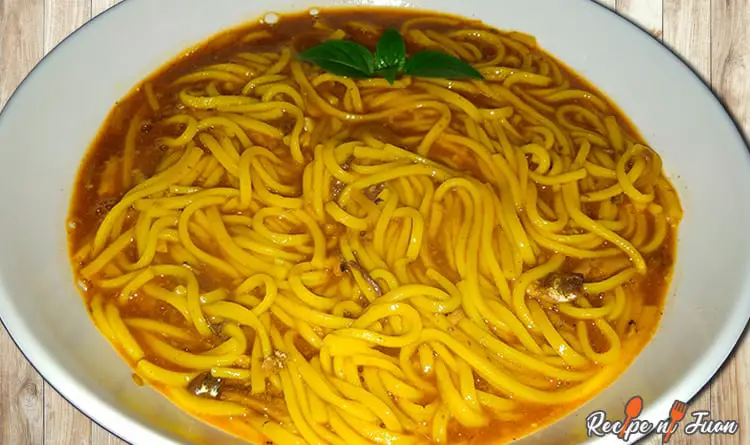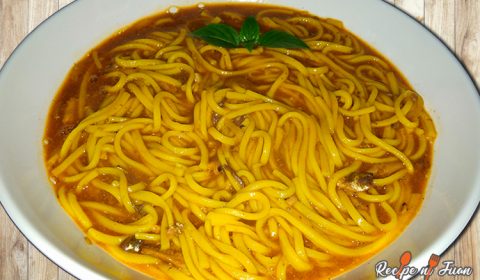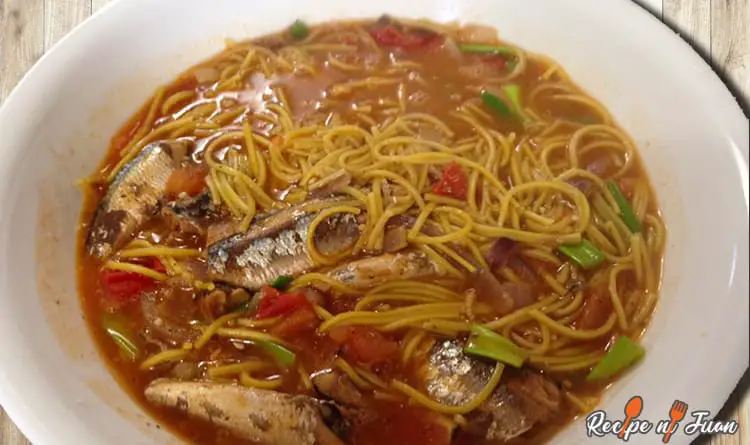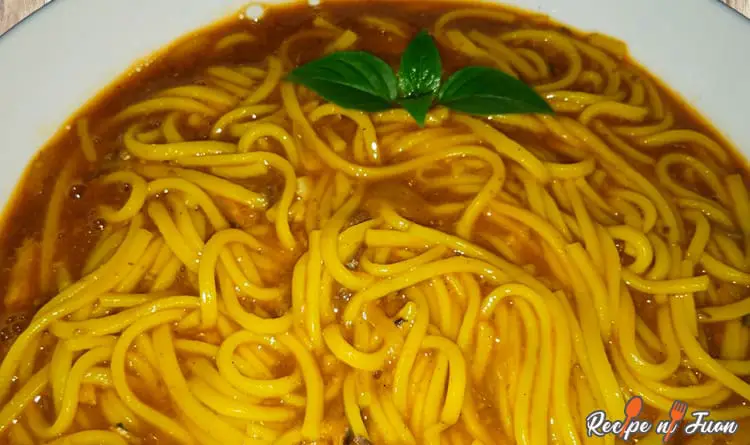How to cook the perfect odong sardines recipe (Udong sardinas)
Whenever there are no celebrations or fiestas, Filipinos tend to get very basic when it comes to their viands.
However, give a Filipino noodles, a can (or 2) of sardines, and water, and the Filipino can still whip up a simple yet tasty dish! This odong recipe proves it.

Native to the Visayas and Mindanao regions, odong is a simple dish with odong noodles as its main ingredient.
Odong noodles (which are yellow in color) are commonly sold in wet markets and variety stores in said regions, so for those in Luzon, misua or sotanghon can also be used as substitutes.


Check out our new cookbook
Bitemybun's family recipes with complete meal planner and recipe guide.
Try it out for free with Kindle Unlimited:
Read for freeIn this post we'll cover:
Odong recipe (odong noodles with sardines)
Ingredients
- ¼ kg odong noodles
- 1 can sardines
- 1 onion chopped
- 4 cloves garlic
- Salt and pepper to taste
- Water
- Spring onion
Instructions
- Saute garlic and onion.
- Add the sardines, salt, and pepper, and simmer for 2 minutes.
- Add water (just enough to cook the noodles).
- Serve it hot and garnish with spring onion.
Nutrition
Check out YouTube user YanYan08 TV’s video on making odong sardines:
Odong recipe preparation and tips
Though this odong recipe makes a noodle dish, the main driver of the taste is the red sardines, as they’re what gives the dish its tasty tomato flavor!
You can switch up the sardines as well. You can use either tinapa or regular canned sardines, or you can also have spicy sardines if you want to kick it up a notch!
Fried tinapa can also be used in this recipe to provide a rough contrast to the somewhat slimy (in a good way) texture of odong. An added treat is that the tinapa will also absorb some of the odong broth, so you’re also guaranteed a tasty sahog.
Real sliced tomatoes can also be added into the sauce to make odong much tastier, as well as chopped celery if you want to make it fancier.

Other vegetables that you can include in this odong recipe include patola and upo. This ups to the nutritional value of the entire meal!
Substitutions and variations
Since odong noodles are exclusively available in the Philippines, it’s difficult to find them in many regions, if not impossible.
However, if you still want to try this amazing recipe, the following are some of the best substitutions you can try in place of odong noodles without affecting the taste much.
Udon noodles
Udon noodles are among the best and most popular substitutes for odong noodles. In fact, odong noodles even take their name from udon noodles! The taste and texture of both are pretty much the same, except that udon noodles don’t have that yellowish tone that odong noodles do.
In places outside the Philippines, udon is a common choice for people who love odong noodle soup.
Misua
Originating from China and known as wheat vermicelli, misua is another great choice to substitute odong noodles with.
As misua noodes are made from wheat, they have the same taste as odong. The only difference is the shape and size of the noodles; they’re much thinner than you’d like.
Miki
Miki or egg noodles are another popular noodles variety in the Philippines that you can use to substitute odong noodles. You can either use these to make perfect odong sadinas or replace the pasta when running short on ingredients.
Soba noodles
Though mostly used as a substitute for udon noodles, you can also use them instead of odong noodles, as they turn out quite well in soups. Since odong sardinas is in the same category, I don’t see a reason why soba noodles won’t fit. ;)
Instant noodles
An instant noodles pack is like one of those good, old friends who will hold your hand when you have no one else!
Though they should be your last resort, you can always use instant noodles when there’s nothing else at hand. They’ll fit with anything.
The best thing? They come with their own special seasoning.
How to serve and eat odong noodles
After the dish is perfectly cooked, you can garnish it with many spices and seasonings, including black pepper, scallions, calamansi, and toasted garlic.
Personally, I use a lot of garlic! This is partly because I love garlic and partly because it balances the fishiness of sardines, giving the noodle soup a very balanced flavor.
Once the odong noodles are perfectly spiced and garnished, it’s time to pair them with boiled rice and serve. Even if the odong recipe already has noodles, the rice will absorb the extra sauce from the broth.
Enjoy it as a spread for your morning pandesal or as a full meal for lunch or dinner.

Similar dishes
If you’re in love with Filipino cuisine, or noodles dishes in general, the following are some similar dishes to odong noodles that you can try.
Odong guisado
It’s more of a variation of the same dish rather than being something different, as it’s cooked with minimal water.
The ingredients are the same, and the taste is the same. However, there’s a much thicker texture and intense taste.
Will you would like it or not? I can’t guarantee it.
Chicken sotanghon soup
One of the most loved comfort foods in the Philippines, schicken sotanghon soup is the Filipino version of chicken noodle soup. It uses shredded chicken, sotanghon noodles, carrots, and cabbage.
Popular garnishes for the dish include roasted garlic and scallions, with fish sauce complementing it as the perfect seasoning. In other words, it’s a nuclear reactor of flavors served in a bowl, ready to explode in your mouth!
Pancit lomi
Pancit lomi is another hearty comfort dish that can easily fill in for odong noodles.
The dish is made with fresh veggies, egg noodles, and chicken. Moreover, the soup is thickened with cornstarch, making it really filling.
If you aren’t a big fan of chicken, you can also use other meat cuts, including pork belly, fish balls, shrimp, diced ham, and crushed chicharrones. Another good addition would be hard-boiled eggs.
You can eat it as a mid-day snack or a main meal!
Chicken mami
I know what you’re thinking: another chicken dish!
Well, yes, but what can I say? The Filipinos just love to put chicken meat in their noodles, and all the different ways they use it each time astonishes me.
That said, of all the recipes I just mentioned, chicken mami has to be the simplest.
The dish mainly uses chicken breast, carrots, egg noodles, scallions, and chicken broth as the main ingredients. Afterward, everyone can add any spices and seasonings of their choice to enhance the flavor to taste.
Batchoy
Batchoy is a staple noodles dish from the Philipines that’s remained the favorite of noodle connoisseurs ever since its very existence.
Unlike the previously mentioned alternatives, the dish uses pig innards and meat entirely, along with egg noodles, guinamos, or shrimp paste. The sweet, salty, and savory flavor of the batchoy is really difficult not to love.
Scarf down a bowl of odong noodles
If you love Filipino cuisine, you can’t just go wrong with odong noodles. This is the perfect comfort dish; the beautiful combination of flavors and the ultimate warmth of the soup is the only thing you need.
In this article, I tried to cover everything you need to know about odong noodles and shared a delicious recipe you can try this upcoming weekend. I hope this piece has been helpful throughout.
If you like what I do, don’t forget to follow my blog. There are a lot of delicious recipes and tidbits I need to share with you.
Until next time! ;)
If you want to learn more about odong noodles, then check out this article.
Check out our new cookbook
Bitemybun's family recipes with complete meal planner and recipe guide.
Try it out for free with Kindle Unlimited:
Read for freeJoost Nusselder, the founder of Bite My Bun is a content marketer, dad and loves trying out new food with Japanese food at the heart of his passion, and together with his team he's been creating in-depth blog articles since 2016 to help loyal readers with recipes and cooking tips.
